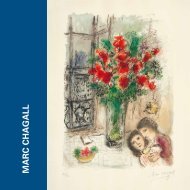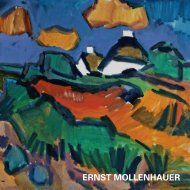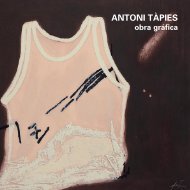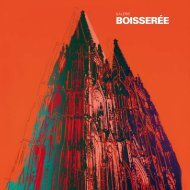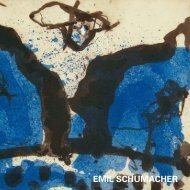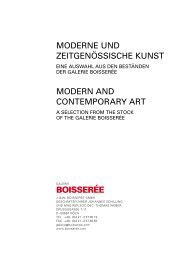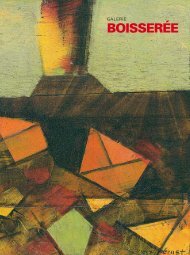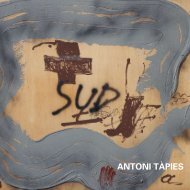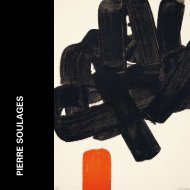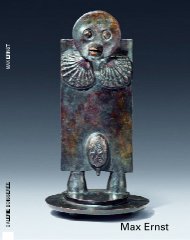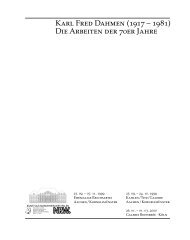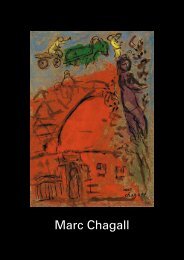MARINO MARINI - Galerie Boisseree
MARINO MARINI - Galerie Boisseree
MARINO MARINI - Galerie Boisseree
You also want an ePaper? Increase the reach of your titles
YUMPU automatically turns print PDFs into web optimized ePapers that Google loves.
<strong>MARINO</strong> <strong>MARINI</strong>
Die <strong>Galerie</strong> Boisserée ist Mitglied im:<br />
Bundesverband des Deutschen Kunst- & Antiquitätenhandels (BDKA) e.V.<br />
Bundesverband Deutscher <strong>Galerie</strong>n und Editionen (BVDG) e.V.<br />
The International Fine Print Dealers Association (IFPDA)<br />
ISBN 978-3-938907-20-7<br />
"In seiner wirtschaftlichen und militärischen Funktion durch die Maschine ersetzt<br />
– Motorflug, Automobil und Panzer –<br />
ist das Pferd schnell zu einem Luxussymbol geworden,<br />
wenn es nicht überhaupt schon für die meisten …<br />
den Charakter eines Mythos angenommen hat."<br />
Marino Marini<br />
Katalogumschlag:<br />
40. "Il Cavaliere" (Der Reiter), Farbaquatintaradierung 1956/1976,<br />
68,8 x 50,5 cm, Pr. 40 x 30 cm, sign., num., Auflage 115 Exemplare, Guastalla A 186 pl. II<br />
[18005]<br />
<strong>MARINO</strong> <strong>MARINI</strong>
Marino Marini im Atelier Mourlot, Paris ca. 1969 © Helene Adant / Fondazione Marino Marini, Pistoia<br />
<strong>MARINO</strong> <strong>MARINI</strong><br />
(Pistoia 1901 – 1980 Viareggio)<br />
"Pferd und Reiter"<br />
Radierungen und Lithographien<br />
GALERIE<br />
BOISSERÉE<br />
J. & W. BOISSERÉE GMBH<br />
GESCHÄFTSFÜHRER JOHANNES SCHILLING<br />
UND MAG.RER.SOC.OEC. THOMAS WEBER<br />
DRUSUSGASSE 7-11<br />
D - 50667 KÖLN<br />
TEL. +49 - (0)2 21 - 2 57 85 19<br />
FAX +49 - (0)2 21 - 2 57 85 50<br />
galerie@boisseree.com<br />
www.boisseree.com
Marino Marini und Charles Sorlier im Atelier Mourlot, Paris ca. 1969 © Helene Adant / Fondazione Marino Marini, Pistoia<br />
Marino Marini – "Pferd und Reiter"<br />
Im Jahr 1901 in Pistoia geboren, erlangt der italienische<br />
Bildhauer, Maler und Graphiker Marino Marini bereits in<br />
den 1930er Jahren öffentliche Anerkennung aufgrund<br />
einiger Einzelausstellungen, Preise und Teilnahmen u. a.<br />
an der Biennale in Venedig oder der Pariser Weltausstellung.<br />
Die Begegnung mit dem berühmten amerikanischen<br />
Kunsthändler Curt Valentin 1947 legt den Grundstein<br />
für seinen internationalen Ruhm. Dieser verhilft ihm zu<br />
Museumsschauen u.a. in New York, denen weitere in<br />
den großen Ausstellungshäusern der Welt folgen. Marini<br />
erhält international namhafte Kunstpreise wie etwa den<br />
ersten Preis für Skulptur der Biennale in Venedig und ist<br />
heute in vielen bedeutenden Museumssammlungen vertreten.<br />
1973 wird der Künstler in Florenz mit einem Marini-<br />
Museum gewürdigt.<br />
Findet Marino Marini zunächst vor allem in seinem bildhauerischen<br />
Schaffen die adäquate Form des künstlerischen<br />
Ausdrucks, stehen seit den 1950er Jahren die<br />
Malerei und Graphik eigenständig diesem Medium gegenüber.<br />
Während seines Studiums der Malerei und Bildhauerei<br />
in Florenz ist die Begegnung mit der Kunst des<br />
Mittelalters, der Renaissance, jedoch besonders mit der<br />
Kunst der Etrusker für sein weiteres Œuvre in Bezug auf<br />
Inhalt und Form prägend. Ausdruck seiner inneren Vision<br />
ist ein verhältnismäßig geringes Repertoire mythischer<br />
und archetypischer Figuren, das in nahezu unendlichen<br />
Variationen, jedoch mit immer neuer und überraschender<br />
Ausdruckskraft in Erscheinung tritt.<br />
Kaum ein Künstlername der Modernen Kunst ist so eng<br />
mit dem Thema "Pferd und Reiter" verbunden, wie der von<br />
Marino Marini. Unsere Ausstellung versucht, diesen Tatbestand<br />
zu dokumentieren, indem sie aus seinem gesamten<br />
graphischen Œuvre von 158 Lithographien und 231<br />
Radierungen eine liebevoll zusammengestellte Auswahl<br />
ausschließlich zu diesem Themenkomplex vorstellt. Unter<br />
den über 60 Exponaten aus drei Jahrzehnten befindet<br />
sich z.B. das vollständige, zwölf Farbaquatintaradierungen<br />
umfassende Mappenwerk "Idea e spazio" (1963) oder<br />
die vollständige Serie der 23 kleinformatigen Radierungen<br />
aus der Mappe "Marino Marini Gravures" - schwarz-weiße<br />
Radierungen, die vorwiegend bereits in den 1950er und<br />
1960er Jahren entstanden, die aber allesamt erst 1970<br />
von den Brüdern Cormmelynck in Paris verlegt worden<br />
sind. Beispiel für die farbig sehr expressive späte Graphik<br />
Marino Marinis sind die vollständige Serie der acht Farblithographien<br />
"Chevaux et Cavaliers" aus dem Jahr 1972<br />
sowie zwei großformatige Farbradierungen aus der Serie<br />
"Marino from Goethe", die kurz vor seinem Tode gedruckt<br />
worden sind.<br />
In dieser Zusammenstellung graphischer Arbeiten kann<br />
der Besucher Marinis Interpretation der traditionsreichen<br />
Ikonographie des Cavaliere nachverfolgen. In der Konstellation<br />
Pferd und Mensch findet der Künstler den Ausdruck<br />
für Mythos und Wirklichkeit, Schönheit und Verderben,<br />
Tapferkeit und menschliches Versagen. Nach den Erfahrungen<br />
des Krieges wird es zum Leitbild seiner tragischen<br />
Weltsicht: Die unruhigen, sich aufbäumenden Tiere mit<br />
ihren stürzenden Reitern sind Marinis Symbol für die<br />
Existenzbefragung der Menschheit. Die Formen bizarrer<br />
Silhouetten von Mensch und Tier sind in ihrer Zweidimensionalität<br />
gebunden und auf wenige Linien und Flächen<br />
reduziert. Der Bildhauer verzichtet in seinen Lithographien<br />
und Radierungen auf jegliche Evozierung von Dreidimensionalität.<br />
Doch in dem genialen Zusammenspiel von<br />
Expressivität, Abstraktion und kühner und dennoch ausgewogener<br />
Kompositionen von Form und Farbe entfalten<br />
sich eine beeindruckende Dynamik und Ausdruckskraft.<br />
Janna Oltmanns
"Zu Beginn meiner Laufbahn hatte ich einmal zufällig ein Atelier gemietet, das den Besitzern<br />
einer Reitschule gehörte. Das bot mir die Gelegenheit, die Tiere täglich zu zeichnen und zu modellieren.<br />
Aber damals waren sie noch weit davon entfernt, mir subjektiv oder apokalyptisch zu erscheinen.<br />
Überhaupt ist mein Werk bis zum Ende des Faschismus und des Krieges ziemlich klassisch,<br />
zurückhaltend und realistisch geblieben …<br />
… ich selbst bin in der Toskana geboren, wo die Entdeckung der etruskischen Kunst in den letzten<br />
fünfzig Jahren eines der größten Ereignisse war. Deshalb stützt sich meine Kunst auch eher<br />
auf Themen, die der Vergangenheit entnommen sind – wie zum Beispiel die Beziehung zwischen<br />
Mensch und Pferd –, als auf moderne Sujets, wie etwa die Beziehung zwischen Mensch und Maschine."<br />
Marino Marini<br />
1. "Pferd und Reiter", Tusche und Pastell auf Papier 1952,<br />
62,2 x 43,2 cm<br />
[18447]
2. "Piccolo Cavaliere" (Kleiner Reiter) aus der Mappe "Marino Marini Gravures" (1970), Radierung 1944/1970,<br />
53,5 x 43 cm, Pr. 8 x 9,4 cm, sign., num., Auflage 81 Exemplare, Guastalla A 24 pl. I<br />
[18161]<br />
3. "Bagnati" (Badende) aus der Mappe "Marino Marini Gravures" (1970), Radierung und Kaltnadel 1950/1970,<br />
53,5 x 43 cm, Pr. 33 x 24,6 cm, sign., num., Auflage 81 Exemplare, Guastalla A 28 pl. XI<br />
[18170]
4. "Pomona" (Pomona) aus der Mappe "Marino Marini Gravures" (1970), Radierung und Kaltnadel 1950/1970,<br />
53,5 x 43 cm, Pr. 35,5 x 29,8 cm, sign., num., Auflage 81 Exemplare, Guastalla A 30 pl. IV<br />
[18164]<br />
5. "Giocoliere" (Gaukler) aus der Mappe "Marino Marini Gravures" (1970), Radierung 1950/1970,<br />
53,5 x 43 cm, Pr. 33 x 24,8 cm, sign., num., Auflage 81 Exemplare, Guastalla A 32 pl. XII<br />
[18171]
6. "Giocoliere" (Gaukler) aus der Mappe "Marino Marini Gravures" (1970), Radierung 1950/1970,<br />
53,5 x 43 cm, Pr. 35 x 29,3 cm, sign., num., Auflage 81 Exemplare, Guastalla A 33 pl. III<br />
[18163]<br />
7. "Giocolieri" (Die Gaukler) aus der Mappe "Marino Marini Gravures" (1970), Radierung und Kaltnadel 1951/1970,<br />
53,5 x 43 cm, Pr. 35,6 x 29,9 cm, sign., num., Auflage 81 Exemplare, Guastalla A 35 pl. VI<br />
[18158]
"In der Kunst ist eine bestimmte Art von Ungenauigkeit<br />
wichtiger als alle Präzision."<br />
Marino Marini<br />
8. "Giocolieri" (Die Gaukler) aus der Mappe "Marino Marini Gravures" (1970), Radierung und Kaltnadel 1951/1970,<br />
53,5 x 43 cm, Pr. 35,6 x 30 cm, sign., num., Auflage 81 Exemplare, Guastalla A 37 pl. II<br />
[18162]
9. "Miracolo" (Wunder) aus der Mappe "Marino Marini Gravures" (1970), Radierung und Kaltnadel 1951/1970,<br />
53,5 x 43 cm, Pr. 35,8 x 30 cm, sign., num., Auflage 81 Exemplare, Guastalla A 38 pl. XVI<br />
[18175]<br />
10. "Cavaliere" (Reiter) aus der Mappe "Marino Marini Gravures" (1970), Radierung und Kaltnadel 1952/1970,<br />
53,5 x 43 cm, Pr. 35,3 x 29,6 cm, sign., num., Auflage 81 Exemplare, Guastalla A 39 pl. XIII<br />
[18172]
11. "Cavaliere" (Reiter) aus der Mappe "Marino Marini Gravures" (1970), Radierung und Kaltnadel 1952/1970,<br />
53,5 x 43 cm, Pr. 35,7 x 30 cm, sign., num., Auflage 81 Exemplare, Guastalla A 40 pl. XIV<br />
[18173]<br />
12. "Giocoliere" (Gaukler) aus der Mappe "Marino Marini Gravures" (1970), Radierung und Kaltnadel 1954/1970,<br />
53,5 x 43 cm, Pr. 35,3 x 29,9 cm, sign., num., Auflage 81 Exemplare, Guastalla A 43 pl. XV<br />
[18174]
"Was mich anbetrifft, so habe ich nicht mehr die Absicht, den Sieg eines Helden zu feiern.<br />
Ich möchte etwas Tragisches ausdrücken, eine Art Menschheitsdämmerung, eher eine Niederlage als einen Sieg.<br />
Wenn Sie meine Reiterstatuen aus den letzten zwölf Jahren nacheinander betrachten, werden Sie bemerken,<br />
dass der Reiter jedes Mal unfähiger wird, sein Pferd zu meistern und dass das Tier in seiner immer<br />
wilderen Angst sich steif macht, anstatt sich aufzubäumen.<br />
Ich glaube allen Ernstes, dass wir dem Ende der Welt entgegengehen.<br />
… Meine Reiterstatuen drücken die Beängstigung aus, die mir die Ereignisse meines Zeitalters verursachen.<br />
Die Unruhe meiner Pferde steigt mit jedem neuen Werk; die immer kraftloser werdenden Reiter haben<br />
die Herrschaft über die Tiere verloren, und die Katastrophen, denen sie erliegen, gleichen denen,<br />
die Sodom und Pompeji vernichtet haben. Ich suche so das letzte Stadium in der Auflösung eines Mythos<br />
zu versinnbildlichen, des Mythos vom heldenhaften, siegreichen Individuum, vom "uomo di virtú"<br />
der Humanisten. Meine in den letzten 14 Jahren entstandenen Werke wollen nicht heroisch,<br />
sondern tragisch sein."<br />
Marino Marini<br />
13. "Composizione di Giocolieri" (Komposition mit Gauklern) aus der Mappe "Marino Marini Gravures" (1970), Radierung 1954/1970,<br />
53,5 x 43 cm, Pr. 29,5 x 24,5 cm, sign., num., Auflage 81 Exemplare, Guastalla A 44 pl. VIII<br />
[18167]
14. "Giocolieri" (Die Gaukler) aus der Mappe "Marino Marini Gravures" (1970), Radierung und Kaltnadel 1955/1970,<br />
53,5 x 43 cm, Pr. 29,5 x 24,5 cm, sign., num., Auflage 81 Exemplare, Guastalla A 45 pl. X<br />
[18169]<br />
15. "Giocolieri e Cavallo" (Gaukler und Pferd) aus der Mappe "Marino Marini Gravures" (1970), Radierung und Kaltnadel 1955/1970,<br />
53,5 x 43 cm, Pr. 29,4 x 24,5 cm, sign., num., Auflage 81 Exemplare, Guastalla A 47 pl. IX<br />
[18168]
16. "Composizione" (Komposition) aus der Mappe "Marino Marini Gravures" (1970), Radierung und Kaltnadel 1956/1970,<br />
53,5 x 43 cm, Pr. 29,8 x 24,9 cm, sign., num., Auflage 81 Exemplare, Guastalla A 50 pl. XVIII<br />
[18177]<br />
17. "Cavallo" (Pferd) aus der Mappe "Marino Marini Gravures" (1970), Radierung und Kaltnadel 1956/1970,<br />
53,5 x 43 cm, Pr. 35,7 x 30,3 cm, sign., num., Auflage 81 Exemplare, Guastalla A 51 pl. XX<br />
[18179]
18. "Composizione di Miracolo" (Komposition eines Wunders) aus der Mappe "Marino Marini Gravures" (1970), Radierung 1960/1970,<br />
53,5 x 43 cm, Pr. 29 x 25 cm, sign., num., Auflage 81 Exemplare, Guastalla A 60 pl. XVII<br />
[18176]<br />
19. "Miracolo" (Wunder) aus der Mappe "Marino Marini Gravures" (1970), Radierung 1960/1970,<br />
53,5 x 43 cm, Pr. 29,3 x 24,5 cm, sign., num., Auflage 81 Exemplare, Guastalla A 61 pl. XIX<br />
[18178]
20. "Il Grido" (Der Schrei) aus der Mappe "Marino Marini Gravures" (1970), Radierung 1962/1970,<br />
53,5 x 43 cm, Pr. 35,6 x 29,8 cm, sign., num., Auflage 81 Exemplare, Guastalla A 69 pl. XXII<br />
[18181]<br />
21. "Il Grido" (Der Schrei) aus der Mappe "Marino Marini Gravures" (1970), Aquatintaradierung 1962/1970,<br />
53,5 x 43 cm, Pr. 25 x 29 cm, sign., num., Auflage 81 Exemplare, Guastalla A 71 pl. XXIII<br />
[18182]
22. "Idea e Spazio" (Idee und Raum), Mappenwerk mit 12 Farbaquatintaradierungen 1963,<br />
53,5 x 40,5 cm, sign., Auflage 128 Exemplare, Guastalla A 73 - A 84 (siehe 23.–34.)<br />
[17553]<br />
23. "Cavalli" (Pferde), Farbaquatintaradierung 1963,<br />
58 x 44,9 cm, Pr. 39 x 29,5 cm, sign., num., Auflage 57 Exemplare, Guastalla A 73 pl. I<br />
[17556]<br />
24. "Giocoliere" (Gaukler), Farbaquatintaradierung 1963,<br />
58,5 x 44,7 cm, Pr. 39,5 x 30 cm, sign., num., Auflage 57 Exemplare, Guastalla A 74 pl. II<br />
[17566]
25. "Giocoliere" (Gaukler), Farbaquatintaradierung 1963,<br />
58,3 x 45,1 cm, Pr. 39,6 x 30 cm, sign., num., Auflage 57 Exemplare, Guastalla A 75 pl. III<br />
[17564]<br />
26. "Fossile Equestre" (Reiterfossil), Farbaquatintaradierung 1963,<br />
58,7 x 45 cm, Pr. 40 x 29,7 cm, sign., num., Auflage 57 Exemplare, Guastalla A 76 pl. IV<br />
[17557] [18337]
27. "Devastazione e Ricostruzione" (Verwüstung und Wiederaufbau), Farbaquatintaradierung 1963,<br />
58,4 x 44,9 cm, Pr. 39,6 x 29,8 cm, sign., num., Auflage 57 Exemplare, Guastalla A 77 pl. V<br />
[17565]<br />
28. "Mattutino" (Morgenandacht), Farbaquatintaradierung 1963,<br />
58,5 x 45,1 cm, Pr. 40 x 30 cm, sign., num., Auflage 57 Exemplare, Guastalla A 78 pl. VI<br />
[17555]
29. "Cavaliere Superstite" (Überlebender Reiter), Farbaquatintaradierung 1963,<br />
58,5 x 45,1 cm, Pr. 39,8 x 29,9 cm, sign., num., Auflage 57 Exemplare, Guastalla A 79 pl. VII<br />
[17558] [18338]<br />
30. "Sogno di Cavaliere" (Traum eines Reiters), Farbaquatintaradierung 1963,<br />
58,5 x 45 cm, Pr. 39,5 x 29,9 cm, sign., num., Auflage 57 Exemplare, Guastalla A 80 pl. VIII<br />
[17560]
31. "Guerriero" (Krieger), Farbaquatintaradierung 1963,<br />
58,6 x 45,1 cm, Pr. 39,7 x 29,8 cm, sign., num., Auflage 57 Exemplare, Guastalla A 81 pl. IX<br />
[17563] [18339]<br />
32. "Spettacolo" (Schauspiel), Farbaquatintaradierung 1963,<br />
58,4 x 45 cm, Pr. 39,5 x 29,8 cm, sign., num., Auflage 57 Exemplare, Guastalla A 82 pl. X<br />
[17562] [18340]
33. "Acrobati" (Akrobaten), Farbaquatintaradierung 1963,<br />
58,5 x 44,9 cm, Pr. 39,5 x 30 cm, sign., num., Auflage 57 Exemplare, Guastalla A 83 pl. XI<br />
[17561]<br />
34. "In Segreto" (Im Geheimen), Farbaquatintaradierung 1963,<br />
58,4 x 45 cm, Pr. 39,5 x 29,9 cm, sign., num., Auflage 57 Exemplare, Guastalla A 84 pl. XII<br />
[17559]
"Künstler sein ist einfach.<br />
Aber einfach sein ist schwer."<br />
Marino Marini<br />
35. "Giocoliere e Cavallo" (Gaukler und Pferd) aus der Mappe "Marino Marini Gravures" (1970), Radierung und Kaltnadel 1969/1970,<br />
53,5 x 43 cm, Pr. 35,4 x 29,7 cm, sign., num., Auflage 81 Exemplare, Guastalla A 99 pl. V<br />
[18165]
36. "Giocoliere" (Gaukler) aus der Mappe "Marino Marini Gravures" (1970), Radierung und Kaltnadel 1969/1970,<br />
53,5 x 43 cm, Pr. 35,6 x 30 cm, sign., num., Auflage 81 Exemplare, Guastalla A 100 pl. VII<br />
[18166]<br />
37. "Composizione" (Komposition) aus der Mappe "Marino Marini Gravures" (1970), Radierung und Kaltnadel 1969/1970,<br />
53,5 x 43 cm, Pr. 35,6 x 30 cm, sign., num., Auflage 81 Exemplare, Guastalla A 101 pl. XXI<br />
[18180]
38. "Miracolo" (Wunder), Farbaquatintaradierung 1970,<br />
61,8 x 56,1 cm, Pr. 44,1 x 39,1 cm, sign., bez., Auflage ca. 80 Exemplare, Guastalla A 104<br />
[17568] [17567]<br />
39. "La Sorpresa I" (Die Überraschung I), Farbaquatintaradierung, Ätz- und Kaltnadelradierung 1973,<br />
99,5 x 69,8 cm, Pr. 64,3 x 48,8 cm, sign., num., Auflage 87 Exemplare, Guastalla A 168 pl. III<br />
[17608]
"Um die großen Errungenschaften des frühen 20. Jahrhunderts zu übertreffen,<br />
ist wahrscheinlich Temperament mehr von Nöten als Intelligenz."<br />
Marino Marini<br />
40. "Il Cavaliere" (Der Reiter), Farbaquatintaradierung 1956/1976,<br />
68,8 x 50,5 cm, Pr. 40 x 30 cm, sign., num., Auflage 115 Exemplare, Guastalla A 186 pl. II<br />
[18005]
"Ich möchte der Menschheit ihre Form bewahren."<br />
Marino Marini<br />
41. aus "Marino from Shakespeare I", Farbaquatintaradierung und Kaltnadel 1977,<br />
76 x 56,8 cm, Pr. 49,7 x 39,5 cm, sign., bez., Auflage 145 Exemplare, Guastalla A 188 pl. II<br />
[18292]
42. "Triade" (Triade), Suite mit 3 Farbaquatintaradierungen 1976-1978,<br />
73,7 x 57,5 cm, sign., num., Auflage 125 Exemplare, Guastalla A 195 - A 197 (siehe 43.–45.)<br />
[17573]<br />
43. "Immagine" (Bild), Farbaquatintaradierung 1976-1978,<br />
72,4 x 56,7 cm, Pr. 50,1 x 36,4 cm, sign., num., Auflage 125 Exemplare, Guastalla A 195 pl. I<br />
[17574]<br />
44. "Giocondo" (Der Heitere), Farbaquatintaradierung 1976-1978,<br />
72,1 x 56,6 cm, Pr. 49,7 x 36,7 cm, sign., num., Auflage 125 Exemplare, Guastalla A 196 pl. II<br />
[17575]
45. "Risveglio" (Erwachen), Farbaquatintaradierung 1976-1978,<br />
72 x 56,7 cm, Pr. 49,6 x 36,4 cm, sign., num., Auflage 125 Exemplare, Guastalla A 197 pl. III<br />
[17576]<br />
46. "Acrobata" (Akrobat), Farbaquatintaradierung 1977,<br />
72,1 x 57,3 cm, Pr. 50,2 x 36,7 cm, bez., Auflage 150 Exemplare, Guastalla A 201<br />
[17571]
47. "Tre Cavalli" (Drei Pferde), Farbaquatintaradierung 1977,<br />
72,4 x 56,5 cm, Pr. 51,4 x 39,6 cm, bez., Auflage 150 Exemplare, Guastalla A 202<br />
[17569]<br />
48. "Cavaliere e Cavallo" (Reiter und Pferd), Farbaquatintaradierung 1977,<br />
72 x 57,3 cm, Pr. 49,8 x 36,8 cm, bez., Auflage 175 Exemplare, Guastalla A 203<br />
[17570]
"Die Ägypter sind zu theatralisch, die Griechen zu heiter.<br />
Ich betrachte mich als einen Abkömmling der Etrusker …<br />
Mich interessieren alle Probleme des Ursprünglichen.<br />
Die Etrusker gehen mich zutiefst an,<br />
denn das Etruskische ist eine ganz ursprüngliche Natur.<br />
Eine wirklich ursprüngliche Natur hat so viel Lebenswärme in sich,<br />
dass sie aus sich selbst weiterlebt und sich durch die Jahrhunderte fortentwickelt.<br />
Deswegen habe ich immer solche Wurzeln menschlichen Schaffens aufzufinden gesucht."<br />
Marino Marini<br />
49. "Tre Cavalli" (Drei Pferde), Farbaquatintaradierung 1977,<br />
72,2 x 57,4 cm, Pr. 49,8 x 36,8 cm, bez., Auflage 175 Exemplare, Guastalla A 204<br />
[17572]
"Ich habe den Anfang jedes Gedanken in der Farbe gesucht,<br />
ob man das dann Malerei oder Zeichnungen nennen soll – das weiß ich nicht."<br />
Marino Marini<br />
50. aus "Marino from Goethe" in blau, schwarz, weiß und grün, Farbaquatintaradierung 1979, verlegt 1980,<br />
90 x 62,7 cm, Pr. 62,5 x 49 cm, sign., num., Auflage 195 Exemplare, Guastalla A 227 pl. III<br />
[17926]
"Ich habe immer das Bedürfnis gehabt zu malen,<br />
und ich beginne nie eine Plastik,<br />
bevor ich nicht ihre Essenz vorher malerisch erforscht habe.<br />
Malen ist mir angeboren als ein ursprüngliches und heftiges Verlangen,<br />
die Farbe zu suchen.<br />
Es gibt keine Plastik, die nicht durch diese Erfahrung hindurchgegangen ist."<br />
Marino Marini<br />
51. aus "Marino from Goethe" in rot, gelb, blau und orange, Farbaquatintaradierung 1979, verlegt 1980,<br />
90,7 x 63,3 cm, Pr. 63,8 x 49,9 cm, sign., num., Auflage 195 Exemplare, Guastalla A 228 pl. IV<br />
[17450]
Marino Marini und Fernand Mourlot im Atelier Mourlot, Paris ca. 1969 © Helene Adant / Fondazione Marino Marini, Pistoia<br />
52. "Ceramica II" aus Mappe "100 Jahre Mourlot", Farblithographie 1955,<br />
66 x 50 cm, Abb. 53,5 x 42,5 cm, sign., num., Auflage 105 Exemplare, Guastalla L 61<br />
[18472]
"Hauptsache ist vor allem die Qualität eines Kunstwerkes.<br />
Ich selbst, als Mensch des Mittelmeerraumes, kann mich nur im Figürlichen frei ausdrücken.<br />
Aber ich akzeptiere und bewundere jede andere Ausdrucksform,<br />
soweit ein Künstler durch sie eine Botschaft mitteilt.<br />
Ein Streichholz kann erregender sein als eine dorische Säule, aber es wäre absurd,<br />
von vorneherein anzunehmen, dass eine Streichholzschachtel die gleiche Bedeutung<br />
habe wie der Parthenon."<br />
Marino Marini<br />
53. "Les Trois Chevaux" (Die drei Pferde), Farblithographie 1958,<br />
66 x 49 cm, Abb. 61 x 43 cm, sign., num., Auflage 58 Exemplare, Guastalla L 75<br />
[17758]
54. "Chevaux et Cavaliers I" (Pferde und Reiter I), Farblithographie 1972,<br />
50 x 65 cm, Abb. 38 x 50 cm, sign., num., Auflage 86 Exemplare, Guastalla L 104 pl. I<br />
[17892]<br />
55. "Chevaux et Cavaliers II" (Pferde und Reiter II), Farblithographie 1972,<br />
50 x 64,7 cm, Abb. 37,5 x 49 cm, sign., num., Auflage 86 Exemplare, Guastalla L 105 pl. II<br />
[17897]
56. "Chevaux et Cavaliers III" (Pferde und Reiter III), Farblithographie 1972,<br />
50 x 64,8 cm, Abb. 38,5 x 50 cm, sign., num., Auflage 86 Exemplare, Guastalla L 106 pl. III<br />
[17903]<br />
57. "Chevaux et Cavaliers IV" (Pferde und Reiter IV), Farblithographie 1972,<br />
50 x 64,7 cm, Abb. 37 x 50,5 cm, sign., num., Auflage 86 Exemplare, Guastalla L 107 pl. IV<br />
[17898]
58. "Chevaux et Cavaliers V" (Pferde und Reiter V), Farblithographie 1972,<br />
50 x 64,8 cm, Abb. 37,8 x 50 cm, sign., num., Auflage 86 Exemplare, Guastalla L 108 pl. V<br />
[17899]<br />
59. "Chevaux et Cavaliers VI" (Pferde und Reiter VI), Farblithographie 1972,<br />
50 x 64,8 cm, Abb. 37 x 50 cm, sign., num., Auflage 86 Exemplare, Guastalla L 109 pl. VI<br />
[17900]
60. "Chevaux et Cavaliers VII" (Pferde und Reiter VII), Farblithographie 1972,<br />
50 x 65 cm, Abb. 37 x 50 cm, sign., num., Auflage 86 Exemplare, Guastalla L 110 pl. VII<br />
[17901]<br />
61. "Chevaux et Cavaliers VIII" (Pferde und Reiter VIII), Farblithographie 1972,<br />
50 x 65 cm, Abb. 39,5 x 52 cm, sign., num., Auflage 86 Exemplare, Guastalla L 111 pl. VIII<br />
[17902]
Biography<br />
1901 Marino Marini was born on February 27 in Pistoia, in Tuscany. His twin sister, Egle, became a poet.<br />
"For me Tuscany is a starting point, which is innate and is part of my being. My discovery of Etruscan art was an extraordinary<br />
event. This is why my art lies on themes from the past, as the link between man and horse, rather than on modern<br />
subjects like the man/machine relationship."<br />
1917 He registers at the Accademia di Belle Arti of Florence where he participates in a drawing class given by<br />
Galileo Chini: "I looked for the origins of every idea in colour," he once said, "whether it’s called painting or drawing, I’m<br />
not sure."<br />
1919 He makes his first trip to Paris where he encounters the new art trends.<br />
1920 He is interested in painting and engraving. In some works from this period – the Virgins (Museo Marino Marini,<br />
Florence) – the influence of Piero della Francesca’s painting is evident.<br />
1922 He concentrates his efforts on sculpture; the ancient art of Pistoia and Tuscany makes a decided impact on his<br />
development.<br />
1923 He begins the long series of exhibitions. He participates in the Rome Biennial and in a group exhibition in<br />
Livorno.<br />
1926 He takes a studio in Florence at the base of the hill of Fiesole.<br />
1927 He takes part in the Third International Exhibition of Decorative Arts at Monza with several pieces.<br />
1928 He participates in the Venice Biennial for the first time with two bronzes and takes part in the exhibition of the<br />
"Gruppo del Novecento Italiano" at the Milano Gallery with ten works including a few terracottas. The Blind Man is one of<br />
his first significant works.<br />
1929 In this year he leaves Florence for Milan: "Milan is the Italian city that is most closely tied to Europe. It has the<br />
same colour as Europe, the same way of life, the same way of working. For me, to be in Milan is to live in the heart of<br />
Europe." He is called to Monza’s Villa Reale art school by Arturo Martini, whom he succeeded at the teaching chair of<br />
sculpture which he holds until 1940. He exhibits with other Italian artists, including Carrà, De Chirico, Sironi, Modigliani,<br />
and Martini, at the Fine Arts Society in Nice and at the Buonaparte publishing house in Paris. At the second exhibition<br />
of the Novecento Italiano at the Palazzo della Permanente in Milan, he presents six works. His terracotta sculpture, the<br />
People, is a revelation to the critics. That same year he makes the portrait of the painter Alberto Magnelli as well as a first<br />
self-portrait in polychrome plaster.<br />
1930 He stays in Paris where he finds many friends such as Campigli, De Chirico, and Severini, and he meets Picasso,<br />
Maillol, Braque, Laurens and Lipchitz. He takes part in an exhibition in Florence with eight paintings and nine sculptures<br />
and in the Venice Biennial with three sculptures and one painting. He creates Ersilia, a wood sculpture that marks an<br />
important stage in his creative development.<br />
1931 Another stay in Paris where he meets Tanguy, De Chirico, Kandinsky and Gonzàlez.<br />
1932 The year of official recognition: he exhibits drawings and sculptures, first in Milan and then in Rome. He becomes<br />
an honorary member of the Accademia di Belle Arti in Florence.<br />
1934 During a trip to Germany he visits the Bamberg Cathedral where he has a chance to admire the equestrian statue<br />
of Henry II (13th century). This "gothic" rider makes a deep impression on him and leads to the creation of the sculpture<br />
Idea for a Rider.<br />
1935 He participates in the second Rome Quadrennial where he wins first prize. His sources, Etruscan and Roman<br />
art, are very evident here. He makes a second self-portrait in bronze and begins the theme of the Pomonas, the Etruscan<br />
goddess symbolizing the fertility of the earth.<br />
1936 The first monography about him is published by Editions him is published by Editions des Chroniques du Jour<br />
(Paris), including an introduction by Paul Fierens. He participates in the twentieth Venice Biennial with nine works. He<br />
begins the Riders series during this period.<br />
1937 He makes several trips to ltaly and Europe. During a new trip to Paris he enjoys the company of many artists:<br />
Kandinsky, Tanguy, Maillol, Picasso, Braque, Laurens, Magnelli, De Chirico... He wins the Grand Prix at the International<br />
Exhibition in Paris. A wood sculpture, the Boxer, of 1935 enters French collections.<br />
1938 On December 14 he marries Mercedes Pedrazzini whom he calls Marina as though to underline their close ties<br />
that would unite them through-out their lives. He participates in the Venice Biennial with two portraits.<br />
1939 He takes part in the third Rome Quadrennial with five works and exhibits in December at the Barbaroux Gallery<br />
in Milan.<br />
1940 He leaves his teaching position at Monza to become a professor in the sculpture department at the Accademia<br />
in Turin.<br />
1941 Marini earns the teaching chair for sculpture at the Accademia di Brera in Milan.<br />
1942 He makes his third self-portrait in polychrome plaster. In November he exhibits a selection of drawings at the<br />
Zodiaco Gallery in Rome. His studio in Monza and his apartment in Milan are destroyed by bombing as are quite a few<br />
of his works. In December, he and his wife seek refuge at Tenero, near Locarno in Switzerland, where he continues to<br />
work.<br />
1943 He makes frequent trips to Zurich and Basel. Here he finds many artists including Giacometti, Banninger,<br />
Wotruba, Germaine Richier, and Haller. He moves closer to lithogaphy and sculpts the Pomonas, a portrait in bronze<br />
of Marina, and the famous Arcangelo (Arch.angel) that marks the inception of a series of Miracles. "The figure of the<br />
Archangel" Marino later says, "[...] greatly interested me in terms of physiognomy and even for the attitude of the body:<br />
its sadness expressed itself all over the face and body, a mournful construction, a sacrificial construction, a bountiful<br />
construction; this is why the body and not just the face interested me."<br />
1944 He participated in the great Exhibition at the Kunstmuseum in Basel along with Wotruba and Germaine Richier.<br />
1945 He exhibits once again with Wotruba and Germaine Richier at the Kunsthalle in Bern, and then in Zurich. He<br />
makes the bronze portrait of Germaine Richier and those in polychrome terracotta of Manuel and Ulrich Gasser that would<br />
be donated to Zurich’s Kunsthaus thirty years later.<br />
1948 They return to Milan where Marino goes back to teaching at Brera. He settles into an atelier in Piazza Mirabello<br />
where he works for the rest of his life. He makes a portrait of Carrà and one of Marina in polychrome stucco. lt is a decisive<br />
year for the artist who makes several journeys and participates in the Venice Biennial where he has an entire room to<br />
himself. He meets Henry Moore and a deep friendship binds them. He meets the most important art dealer of the period<br />
– Curt Valentin – who falls in love with his works, so much so that he acquires many of them and becomes his agent in<br />
the United States, where he organizes many exhibitions. What’s more he meets Peggy Guggenheim who buys a bronze<br />
model of the The Town’s Guardian Angel, placing it in front of her homonymous museum on Venice’s Grand Canal. From<br />
this year on, his painterly production increases considerably.<br />
1949 He takes part in the exhibition "Twentieth Century Italian Art" organized by Luigi Toninelli at the Museum of<br />
Modem Art in New York. This is the year in which he executes one of his major works The Town’s Guardian Angel which
he wouid speak of many years later: "The gentle expression of the Guggenheim’s Rider is joyous... the war had just barely<br />
ended and the man on the horse, arms spread open, made you imagine that he could cry out what he was..."<br />
1950 In his gallery, the Bulcholz Gallery, Curt Valentin organizes the first Marini exhibition in New York with drawings,<br />
lithographs and 28 sculptures. It runs from February 14 to March 11. The artist stays in the United States form February<br />
to June. He meets Stravinsky during this period and immediately does his portrait (a second version would be executed in<br />
1951); he also meets Arp, Beckmann, Feininger, Dalí, and Mies van der Rohe. Kaufmann, the owner of Bear Run House,<br />
one of Frank Lloyd Wright’s masterpieces, purchases an example of The Town’s Guardian Angel and places it near the<br />
waterfall close to his house. Back from the United States, Marino stops in London where he visits Henry Moore. The<br />
Hanover Gallery holds an exhibition dedicated to him.<br />
1952 He receives the international Grand Prize of Sculpture at the Venice Biennial. Again he has an exhibition room<br />
to himself where he displays twelve sculptures and six paintings. He works on six lithographs in Paris in the atelier of<br />
Fernand Mourlot. He meets Masson, Braque, Ungaretti, and Brancusi. The Miracles completely absorb him, but he continues<br />
the series of portraits, including the bronze one of Curt Valentin (a second version would be realized in 1954).<br />
1953 Many exhibitions take place throughout Europe: in Göteborg, Stockholm, Copenhagen and Oslo. The same<br />
happens in the United States: in Cincinatti and in New York at Curt Valentin’s Gallery, then at the Museum of Modern Art<br />
where he takes part in the exhibition "Sculpture in the Twentieth Century". The monography edited by Umbro Apollonio<br />
is published.<br />
1954 He wins the Grand Prize from the Lincei Academy in Rome. During the summer he and his wife move into the<br />
house she designed, the Germinaia at Forte dei Marmi. This is where Curt Valentin dies. This was a great loss for the<br />
artist who admired him and had great esteem for him. Pierre Matisse becomes Marini’s new dealer in the United States.<br />
Pablo Neruda meets Marino at the Germinaia.<br />
1955 Personal exhibitions in Germany, France (exhibition of lithographies at the Berggruen Gallery in Paris), Holland,<br />
and the United States (New York). He participates in Kassel’s Documenta.<br />
1956 Personal exhibitions in London and Los Angeles. He takes part in the international Exhibition at the Rodin<br />
Museum in Paris. Marino confronts the new theme of the Warrior.<br />
1957 Personal exhibitions in Dusseldorf and New York.<br />
1958 He exhibits some works together with those of Giacometti, Matisse, and Moore at the Hanover Galiery in<br />
London. The Bayerische Staatsgemaldesammlung in Munich purchases a large Miracle.<br />
1959 He makes an equestrian monument in bronze for a square in The Hague in memory of the horror of the war. lt<br />
is the largest work in bronze made by the artist (6 metres high). The base bears the inscription: "We built, we destroyed,<br />
and a sad song weighed on the world." He participates in Kassel’s Documenta.<br />
1960 The Germanisches Nationalmuseum in Nuremberg purchases a large Warrior. The large Miracle of 1953 is<br />
piaced in Rotterdam in memory of those who fell at war.<br />
1961 He executes a portrait of Henry Miller at Forte dei Marmi, where he also did Henry Moore’s.<br />
1962 Zurich’s Kunsthaus presents a major retrospective reuniting more than two hundred works and meets with great<br />
success. He makes the portrait of Marc Chagall and Henry Moore. Moore donates his to the National Portrait Gallery in<br />
London.<br />
1963 He presents a few paintings at the Toninelli Gallery in Milan and a few sculptures at the Calder – Marini Exhibition<br />
at the Gallery of Modern Art in Basel. In Arp’s atelier, he makes the artist’s portrait. Franco Russoli’s monography is<br />
published.<br />
1964 A major painting exhibition at the Museum Boymans Van Beuningen in Rotterdam. He participates in Kassel’s<br />
Documenta.<br />
1966 An important exhibition of sculpture, paintings, and drawings at Palazzo Venezia in Rome, curated by Giovanni<br />
Carandente.<br />
1967 He goes to Berlin to meet with Mies van der Rohe, who is supervising the construction of the Nationalgalerie,<br />
and makes a portrait of him that was commissioned by the museum itself.<br />
1968 He receives the highest German honour at Gottingen: membership in the Orden Pour le mérite of science and<br />
art. Marino is very proud of this honour which had previously been conceded to only two great ltalians: Alessandro Manzoni<br />
and Giuseppe Verdi. He works mostly in stone, but painting remains one of his greatest interests: "I have always had<br />
the need to paint and I never begin a sculpture before first investigating its essence pictorially... To conceive of a form is<br />
to recognize the colour, it is the vision of colour, to paint is to enter the poetry of the fact and the fact becomes reality<br />
through the act."<br />
1969 Exhibition "From Colour to Form" at the Bibliothèque Nationale in Paris.<br />
1971 Creation of the Idea for the Miracle.<br />
1972 He becomes an honorary citizen of the City of Milan. In this year a retrospective of his works, dedicated to<br />
"Twentieth Century Personalities", is held at the Piero della Francesca research centre. Marino and Marina donate an<br />
important collection of works, sculptures (above all portraits), paintings, and drawings.<br />
1973 The inauguration of the Museo Marino Marini within the Galleria d’Arie Moderna in Milan. At the request of the<br />
director of La Scala, Paolo Grassi, he creates the decoration and costumes for Stravinsky’s The Rite of Spring.<br />
1974 Two large sculptures are donated to the Musei Vaticani in Rome: a Miracle in stone, donated by Gianni Agnelli,<br />
and a Rider in polychrome wood from the Battiato Collection.<br />
1975 Exhibition at the Castello Sforzesco in Milan of twenty-one paintings from his early years.<br />
1976 Munich’s Staatsgalerie Moderner Kunst dedicates a permanent exhibition space for paintings and sculpture to<br />
him. A retrospective of his graphic works is presented in Bavarian state museums, and then in Turin and Paris.<br />
1977 He completes his last sculpture, a portrait of Oskar Kokoschka which he began in 1976.<br />
1978 An itinerant exhibition of sculpture and painting in Japan’s museums in Tokyo, Yamagata, Sapporo, Kobe, and<br />
Kumamoto. In the same year he gives a bronze Rider to the Museum of Modem Art in Paris.<br />
1979 lnauguration at the Pistoia’s Town Hall of a Documentation Centre dedicated to Marino Marini’s works; it has a<br />
library, a photographic library, a video library, and many sculptures including a large Miracle.<br />
1980 He dies on August 6 in Viareggio at age seventy-nine.<br />
1988 Florence’s Museo Marino Marini opens in the ancient church of San Pancrazio. Part of the sculptural and pictorial<br />
works donated to the museum come from the Marina Marini Collection.<br />
1990 At the Vatican, in the Borgia’s apartments, inauguration of the Sala delle Arti Liberali, following a considerable<br />
donation by Marina Marini.<br />
1990 The Fondazione Marino Marini at the Palazzo del Tau opens in Pistoia and is destined to ensure the conservation<br />
and propagation of his work.
Herausgeber und Satz:<br />
Thomas Weber, <strong>Galerie</strong> Boisserée<br />
Digitale Scans bzw. Photographie der Exponate:<br />
Emma Rubio, Janna Oltmanns, Thomas Weber, <strong>Galerie</strong> Boisserée<br />
Katalogisierung der Objekte:<br />
Mona Fossen, Janna Oltmanns, <strong>Galerie</strong> Boisserée<br />
Einführender Text:<br />
Janna Oltmanns, <strong>Galerie</strong> Boisserée<br />
Sammlung der Zitate:<br />
Mona Fossen, Janna Oltmanns, <strong>Galerie</strong> Boisserée<br />
Photographien von Marino Marini:<br />
© Helene Adant / Fondazione Marino Marini, Pistoia<br />
Farbkorrektur:<br />
Urszula Neuss,<br />
Grafische Werkstatt, Druckerei und Verlag Gebrüder Kopp GmbH & Co. KG, Köln<br />
Druck und Herstellung:<br />
Grafische Werkstatt, Druckerei und Verlag Gebrüder Kopp GmbH & Co. KG, Köln<br />
ISBN 978-3-938907-20-7<br />
© 2010 <strong>Galerie</strong> Boisserée, Köln und VG BILD-KUNST, Bonn<br />
© 2010 Helene Adant / Fondazione Marino Marini, Pistoia<br />
GALERIE<br />
BOISSERÉE<br />
J. & W. BOISSERÉE GMBH<br />
GESCHÄFTSFÜHRER JOHANNES SCHILLING<br />
UND MAG.RER.SOC.OEC. THOMAS WEBER<br />
DRUSUSGASSE 7-11<br />
D - 50667 KÖLN<br />
TEL. +49 - (0)2 21 - 2 57 85 19<br />
FAX +49 - (0)2 21 - 2 57 85 50<br />
galerie@boisseree.com<br />
www.boisseree.com<br />
Wir laden Sie ein, unsere Homepage zu besuchen:<br />
www.boisseree.com<br />
Dort informieren wir Sie umfassend über die aktuelle Ausstellung<br />
und unsere geplanten Aktivitäten.<br />
Neben der derzeitigen Ausstellung können Sie sich auch die vergangenen<br />
mit nahezu allen bzw. zahlreichen ausgestellten Exponaten<br />
ansehen. Wir bemühen uns den Bestand der <strong>Galerie</strong> aktuell<br />
zu päsentieren.<br />
Auf der Homepage besteht für Sie auch die Möglichkeit, sich in<br />
unsere Newsgroup per E-Mail einzutragen. Wir werden Sie dann<br />
mit unserem Newsletter vorab über kommende Ausstellungen<br />
und das <strong>Galerie</strong>programm informieren.<br />
Über den virtuellen Besuch unserer <strong>Galerie</strong>räume, aber insbesondere<br />
über Ihren persönlichen Besuch freuen wir uns.
GALERIE<br />
BOISSERÉE<br />
J. & W. BOISSERÉE GMBH<br />
GESCHÄFTSFÜHRER JOHANNES SCHILLING<br />
UND MAG.RER.SOC.OEC. THOMAS WEBER<br />
DRUSUSGASSE 7-11<br />
D - 50667 KÖLN<br />
TEL. +49 - (0)2 21 - 2 57 85 19<br />
FAX +49 - (0)2 21 - 2 57 85 50<br />
galerie@boisseree.com<br />
www.boisseree.com



